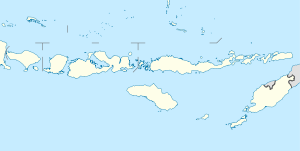North Amanatun
| Kecamatan Amanatun Utara North Amanatun District
|
|
|---|---|
 |
|
| Basic data | |
| Country | Indonesia |
| province | East Nusa Tenggara |
| Administrative district | South Central Timor |
| surface | 105.8 km² |
| Residents | 17,424 (2017) |
| density | 165 inhabitants per km² |
| ISO 3166-2 | ID-NT |
Coordinates: 9 ° 41 ′ S , 124 ° 42 ′ E
North Amanatun ( Indonesian Amanatun Utara ) is an Indonesian district ( Kecamatan ) in the west of the island of Timor .
geography
| "Village" (Desa) | surface | Residents | Population density |
|---|---|---|---|
| Lilo | 6.00 km² | 1,544 | 257 |
| Tauanas | 10.20 km² | 834 | 82 |
| Fotilo | 13.66 km² | 2,359 | 173 |
| Nasi | 12.06 km² | 1,687 | 140 |
| Snok | 11.50 km² | 2,289 | 199 |
| Tumu | 27.39 km² | 2,643 | 96 |
| Fatu Oni | 11.38 km² | 1,803 | 158 |
| Sono | 10.29 km² | 2,729 | 265 |
| Muna | 3.36 km² | 1,536 | 457 |
Location in East Nusa Tenggara Province
|
The district is located in the east of the administrative district of South Central Timor (Timor Tengah Selatan) in the province of East Nusa Tenggara (Nusa Tenggara Timur) . In the south-west lies the Noebana district , in the west east Amanuban (Amanuban Timur) and Fatukopa , in the north-east Kokbaun , in the east Toiana and in the south Santian and Noebana.
North Amanatun has an area of 105.84 km² and is divided into the nine Desa Lilo , Tauanas , Fotilo , Nasi , Snok , Tumu , Fatu Oni , Sono and Muna . The Desa are again divided into a total of 31 Dusun (sub-villages). While Muna is only 54 m above sea level , Lilo is at 538 m above sea level. As in Timor, the tropical climate is divided into a rainy and a dry season . From August to December there is largely drought, while most of the rainfall occurs in February. In 2017, 76 rainy days were recorded with a total amount of 1,302.5 millimeters of precipitation.
flora
Among other things, teak can be found in the district .
Residents
In 2017, 17,424 people lived in North Amanatun. 8,259 were men, 9,165 women. The population density was 165 people per square kilometer. There were 13 Catholic and 30 Protestant churches and chapels in the district.
Economy, infrastructure and transport
Most of the district's residents make a living from agriculture. Cattle (5,355), horses (three), buffaloes (three), pigs (9,455), goats (356) and chickens (17,344) are kept as pets. Corn is grown on 2,125 hectares, sweet potatoes on 37 hectares and peanuts on 52 hectares. Rice is not grown in North Amanatun. Other agricultural products include onions, garlic, Indian mustard, beans, cucumbers, cauli flowers, pumpkins, avocados, mangoes, tangerines, oranges, guavas, papayas and bananas. Pecans, cashews, coffee, cocoa and vanilla come from plantations.
There are 21 elementary schools, five middle schools and one secondary school in North Amanatun. A communal health center ( Puskesmas ) in Snok and a medical care center ( Puskesmas Pembantu ) in Fotilo are available for medical care . Two doctors, twelve midwives and ten nurses are based in the district.
Web links
- Statistical data from North Amanatun District 2018 (Indonesian).


